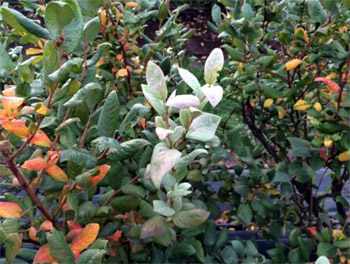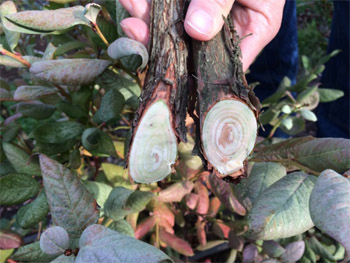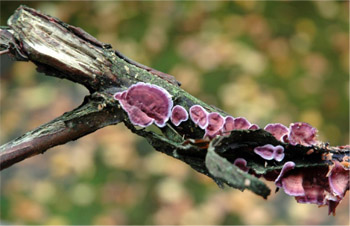
Silver Leaf of Blueberry - Chondrostereum purpureum
From Extension Plant Pathology
Oregon State University Extension Service January 2015
Cause:
Silver leaf is not new to the PNW as it has been a minor problem on stone fruit for many years. It is a disease where the fungus (Chondrostereum purpureum) invades cut or wounded stems and limbs of a wide variety of plants. This fungus was confirmed for the first time in 2014 by the OSU Plant Clinic on ‘Draper’ and ‘Liberty’ blueberry with silver leaf symptoms although samples with these symptoms had been received since 2009. Symptoms, of the disease have been seen in western Oregon and northwest Washington. The cultivars ‘Brigitta,' ‘Bluecrop’ and ‘Duke’ are susceptible in other blueberry production areas in addition to ‘Draper.'

Silver leaf is also known to affect sweet cherries, apples, pears, peaches, plums, nectarines, some small fruits, alder, willow and poplar. The fungus is a saprophyte growing on dead trees, prunings, stumps, posts and fallen logs. Small bracket-like fruiting bodies are produced in the fall and winter during moist weather. Spores are produced during wet weather and blown for miles. Spores germinate and enter living tissue through a fresh surface wound such as pruning cuts, mechanical injury, winter injury and/or insect damage. Pruning cuts are most susceptible within one week of wounding. After infection, fungus growth is systemic into the root crown of the bush.
Symptoms:
During the summer the top surface of young leaves turns silvery. Symptoms may start on 1 or 2 branches, which show reduced growth and die in two or three seasons. New branches on the same plant continue to develop symptoms until the whole bush is affected. Symptoms in ‘Draper’ seem to begin about three or four years after planting.

The heartwood of infected stems may turn brown or exhibit purple to brown concentric rings of discoloration. This discoloration is more accentuated at the base of bushes and branches and may not be found in stem cross sections higher up on symptomatic branches. The root system does not show symptoms.

Fruiting bodies (basidiocarps) may develop in the fall on the surface of dead or dying branches. Fruiting bodies can be variable in form appearing either as flat incrustations up to several inches long that cover infected branches or as bracket-shaped projections, 1 to 3 inches wide, arranged in tiers. Bracket undersurfaces, the sporulating surfaces, usually are purple although color may vary from salmon pink to purple.
Cultural Control:
- Rogue out and destroy symptomatic plants. Destroy all dead wood removed from 'Draper' fields.
- Burn all prunings. The fungus will fruit only on dead wood, and pruning piles are often the source of reinfection in other fruit systems.
- Take care to prevent unnecessary injuries to bushes. Use proper branch pruning techniques.
- If possible, prune 'Draper' in dry weather such as after harvest in late summer before the fall rains.
Chemical Control:
Injection of fungicides into diseased trees has not had an effect on disease progression in tree fruit. Chemical protection of pruning wounds is possible but there are no chemical registrations.
Biological Control:
The fungus Trichoderma viride has been shown to protect pruning wounds but there are no registrations.
References:
France, A., Santelices, C., Buddie, A. and Kirk, P. 2009. Silver leaf: First worldwide report of a new and harmful disease on blueberry. Proceedings of the IXth IS on Vaccinium. Acta Hort 810:341-344.
Edited by Jay W. Pscheidt, Extension Plant Pathology Specialist, Oregon State University, Corvallis, OR 97331-2903.
Trade name products are mentioned as illustrations only. This mention does not mean that the Oregon State University Extension Service either endorses these products or intends to discriminate against products not mentioned.
Oregon State University Extension Service offers educational programs, activities, and materials without discrimination based on age, color, disability, gender identity or expression, genetic information, marital status, national origin, race, religion, sex, sexual orientation, or veteran’s status. Oregon State University Extension Service is an Equal Opportunity Employer
|
